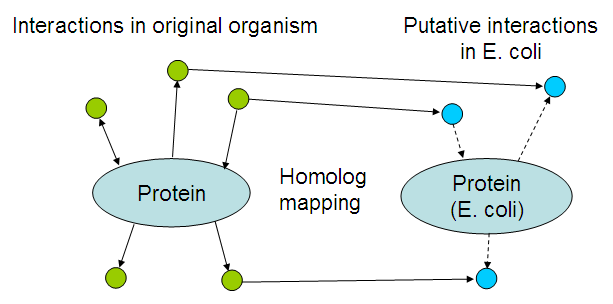Team:TU Delft/Modeling/interaction-mapping
From 2010.igem.org
Problems with introducing new genes
In our project, we are taking genes from various organisms and putting them as a biobrick plasmid into E. coli. This may cause various unexpected problems in the newly designed biological system:
- The protein in the original organism may need some other functional partners (proteins or RNAs) in order to behave correctly (I.A.W. a part of the imported system is missing)
- The introduced protein can interact with local proteins that are not ment to interact.
Searching for interactions
To get an idea of which interactions may occur, interactions within the original organisms where mapped to their E. coli homologs:

In more detail:
- The sequence of every introduced protein (See the coding biobricks) was blasted against the [http://string-db.org/newstring_cgi/show_input_page.pl?input_page_type=single_sequence STRING protein database]. This resulted in a number of proteins that are either the correct proteins, or homologs of the introduced proteins.
| Biobrick | Short name | STRING Database ID |
| [http://partsregistry.org/Part:BBa_K398000 BBa_K398000] | LadA | [http://string-db.org/version_8_3/newstring_cgi/show_network_section.pl?identifier=420246.GTNG_3499&all_channels_on=1&interactive=yes&network_flavor=evidence&targetmode=proteins 420246.GTNG_3499] |
| [http://partsregistry.org/Part:BBa_K398001 BBa_K398001] | AlkB | [http://string-db.org/version_8_3/newstring_cgi/show_network_section.pl?identifier=101510.RHA1_ro02534&all_channels_on=1&interactive=yes&network_flavor=evidence&targetmode=proteins 101510.RHA1_ro02534] |
| [http://partsregistry.org/Part:BBa_K398002 BBa_K398002] | RubA3 | [http://string-db.org/version_8_3/newstring_cgi/show_network_section.pl?identifier=246196.MSMEG_1840&all_channels_on=1&interactive=yes&network_flavor=evidence&targetmode=proteins 246196.MSMEG_1840] |
| [http://partsregistry.org/Part:BBa_K398003 BBa_K398003] | RubA4 | [http://string-db.org/version_8_3/newstring_cgi/show_network_section.pl?identifier=350058.Mvan_1744&all_channels_on=1&interactive=yes&network_flavor=evidence&targetmode=proteins 350058.Mvan_1744] |
| [http://partsregistry.org/Part:BBa_K398004 BBa_K398004] | Rubredoxin reductase | [http://string-db.org/version_8_3/newstring_cgi/show_network_section.pl?identifier=101510.RHA1_ro02537&all_channels_on=1&interactive=yes&network_flavor=evidence&targetmode=proteins 101510.RHA1_ro02537] |
| [http://partsregistry.org/Part:BBa_K398005 BBa_K398005] | Bt-ADH | [http://string-db.org/version_8_3/newstring_cgi/show_network_section.pl?identifier=235909.GK0984&all_channels_on=1&interactive=yes&network_flavor=evidence&targetmode=proteins 235909.GK0984] |
| [http://partsregistry.org/Part:BBa_K398006 BBa_K398006] | Bt-ALDH | [http://string-db.org/version_8_3/newstring_cgi/show_network_section.pl?identifier=235909.GK2772&all_channels_on=1&interactive=yes&network_flavor=evidence&targetmode=proteins 235909.GK2772] |
| [http://partsregistry.org/Part:BBa_K398100 BBa_K398100] | bbc1 | Dropped: Not in STRING database, and
protein sequence blast only resulted in eukaryotic homologs |
| [http://partsregistry.org/Part:BBa_K398200 BBa_K398200] | AlnA | [http://string-db.org/version_8_3/newstring_cgi/show_network_section.pl?identifier=62977.ACIAD0697&all_channels_on=1&interactive=yes&network_flavor=evidence&targetmode=proteins 62977.ACIAD0697] |
| [http://partsregistry.org/Part:BBa_K398201 BBa_K398201] | OprG | [http://string-db.org/version_8_3/newstring_cgi/show_network_section.pl?identifier=160488.PP_0504&all_channels_on=1&interactive=yes&network_flavor=evidence&targetmode=proteins 160488.PP_0504] |
| [http://partsregistry.org/Part:BBa_K398300 BBa_K398300] | AlkS | [http://string-db.org/version_8_3/newstring_cgi/show_network_section.pl?identifier=399739.Pmen_0429&all_channels_on=1&interactive=yes&network_flavor=evidence&targetmode=proteins 399739.Pmen_0429] |
| [http://partsregistry.org/Part:BBa_K398400 BBa_K398400] | Prefoldin-alpha | [http://string-db.org/version_8_3/newstring_cgi/show_network_section.pl?identifier=70601.PH0527&all_channels_on=1&interactive=yes&network_flavor=evidence&targetmode=proteins 70601.PH0527] |
| [http://partsregistry.org/Part:BBa_K398401 BBa_K398401] | Prefoldin-beta | [http://string-db.org/version_8_3/newstring_cgi/show_network_section.pl?identifier=70601.PH0532&all_channels_on=1&interactive=yes&network_flavor=evidence&targetmode=proteins 70601.PH0532] |
- For each protein, the interactions stored in STRING where gathered.
- For each found interacting protein, E. coli homologs where gathered.
- This results in a combination of interactions with their E. coli homologs. The likelyness of this being a true interaction depends on the STRING interaction score (Data from publication text mining, microarrays and other sources) and the BLAST score (The homolog mapping step).
Software development
An application was developed that can run these queries on a PostgreSQL server running the STRING database. This database can be [http://string-db.org/newstring_cgi/show_download_page.pl downloaded] for free for academic use. Unfortunately, the STRING API does not provide enough functionality to do the homolog mapping, so a PostgreSQL database with the STRING data is always needed.
Source code is available in a [http://github.com/jcnossen/InteractionHomologMapping github repository], or by directly downloading the [http://github.com/jcnossen/InteractionHomologMapping/zipball/master code in zip format]
Result
Presentation of results is still work in progress. The network below shows the putative interactions of the prefoldin biobricks, and any interacting proteins that do not have homologs in E. coli.
- Green: E. coli homologs of a Pyrococcus protein that is interacting with prefoldin, according to the STRING database.
- Red: Missing homolog.
As prefoldin is working in E. coli, one could argue that this is because it is interacting with the green proteins. This could be a hint for more research into the Pyrococcus prefoldin proteins.
 "
"